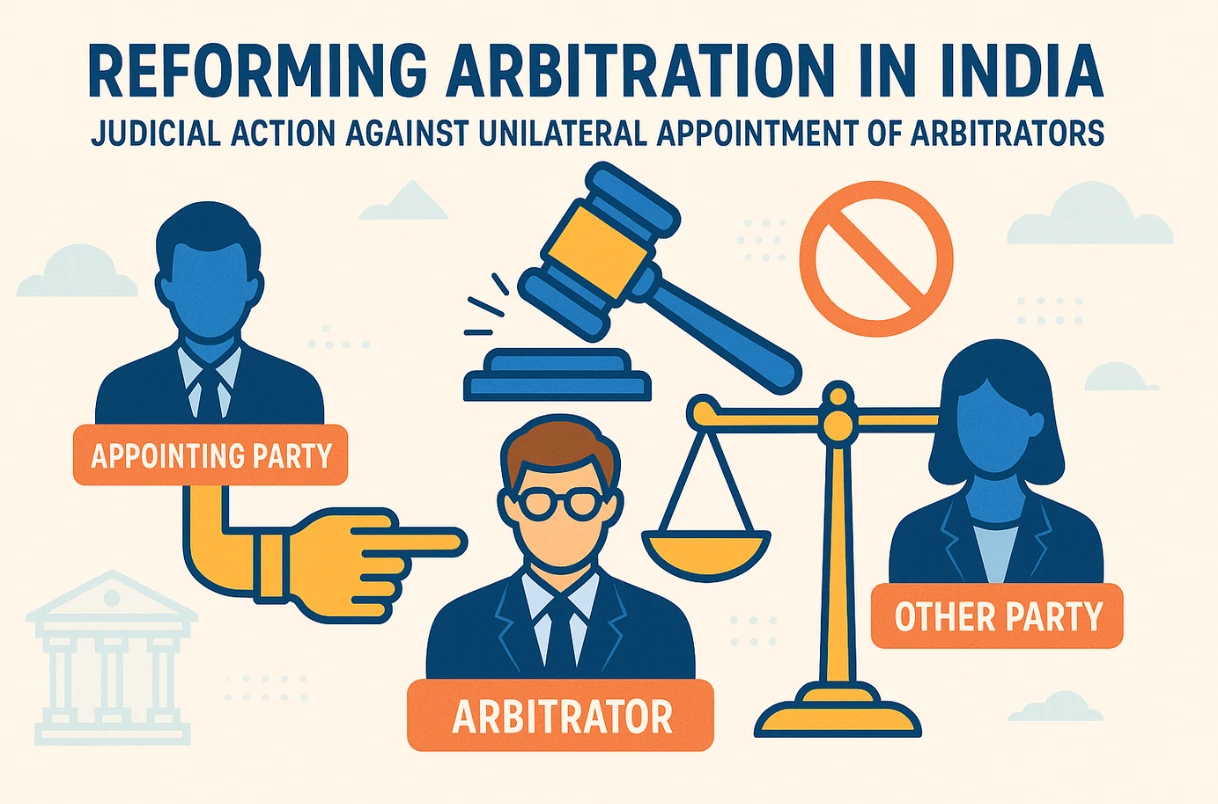Rights of Landowners in Land Acquisition Proceedings

By – Sangeeth Narayanan and Debasmita Goswami
Table of Contents
Introduction: The Need for Land Acquisition in India’s Development
Land is one of the most important resources which is required for carrying out any developmental projects / infrastructure projects. The success of any developmental project depends largely upon the ease of availability of land for executing the project. Further, availability of land becomes crucial for infrastructure projects devised for public welfare be it for building roads to the remotest parts of the country and even for economic growth of a state / region by way of allotment of lands to industries by various industrial development corporations under the State governments. This necessity falls under what is broadly referred to as land acquisition, defined as the process by which the government legally obtains private land for public purposes.
Just as how important the availability of land is for the successful execution of these projects, it is equally a complex and sensitive process as the interests of the landowners needs to be balanced with the need for carrying out the developmental projects. Balancing the interests of the landowners is also important as often it is the biggest roadblock a government faces while acquiring large parcels of land for its projects. It is not uncommon in India that a project of public interest does not see the light of the day due to the project coming to a standstill at its very first stage due to the litigations initiated by various landowners affected by the project. In such a scenario, it becomes essential to have a land acquisition regime which provides equal importance to the interests of the landowners.
Evolution of Land Acquisition Laws in India
Shortcomings of the Land Acquisition Act, 1894
The process of land acquisition in India was governed by the Land Acquisition Act, 1894, a colonial-era legislation that formed the core of the land act framework in India for over a century. However, being an act which was over a century old, it was felt that the 1894 Act was lacking in provisions in favour of the interests of the landowners be it in the form of compensation or rehabilitation. Over the years, this land acquisition act India relied on was criticized for being outdated and disproportionately in favour of the state.
Though on the face of it, the 1894 Act seemed to adequately take into consideration the rights / interests of the landowners, however several shortcomings were observed during the practical implementation of the land acquisition process.
On the face of it, the 1894 Act seemed to properly identify all the affected parties to a land acquisition process. It also seemed that the 1894 Act gave the landowners sufficient opportunity of being heard and sufficiently compensated on by following several ways of deciding the compensation amount including consideration of marked value of the land, assets present on the land, income derived from the land and a solatium. However, during the actual process of land acquisition, it was observed that the procedure under the 1894 Act severely lacked in identifying all kinds of affected parties. Other than the actual landowners, the 1894 Act failed to consider the rights/interest of the other affected parties to the land acquisition such as landless labourers, sharecroppers, people carrying out agriculture etc. The rights of these people were ignored during land acquisition, and they were not eligible for compensation.
Another major drawback felt regarding the 1894 Act was that it lacked a clear formula with respect to calculation of the compensation amount. There were multiple ways of calculating the compensation amount and the acquiring authorities often used to consider the least value derived from all the possible methodologies available for deciding the compensation amount. As a result, the landowners were not adequately compensated for their land.
Also, as there was a huge time lag between determining the compensation and awarding the compensation, the tangible value of the land got further reduced. All these deficiencies in the 1894 Act, often resulted in each land acquisition proceeding to be challenged before a court of law. As a result of the various deficiencies in the 1894 Act and more specifically as the said Act was severely outdated, it was felt necessary to overhaul the legislation governing the land acquisition proceedings which culminated in the passing of the 2013 Act.
The Right to Fair Compensation and Transparency in Land Acquisition Act, 2013
In order to address and resolve the imbalance that was prevalent between the interests of the government and the landowners, the Right to Fair Compensation and Transparency in Land Acquisition, Rehabilitation and Resettlement Act, 2013 (“2013 Act”) was enacted by the Parliament and replaced the 1894 Act.
The 2013 Act underscored fairness, transparency and rights of the landowners thereby marking a significant shift from the 1894 Act. As per the 2013 Act “landowner” is defined as any person whose name is recorded as the owner of the land or building in the records of the authority; any person who is granted forest rights under the Scheduled Tribes and other Traditional Forest Dwellers (Recognition of Forest Rights) Act, 2006 is also a landowner. Further, any person who is entitled to be granted Patta rights on the land under any law of the State including assigned lands is also considered to be a landowner.
Government Powers and Obligations Under the 2013 Act
As per Section 2 of the 2013 Act, the provisions of the land acquisition, compensation, rehabilitation and resettlement shall apply when the Government acquires land for its own use, holds and controls, including for Public Sector Undertakings and for public purpose relating to naval, military, air force and armed forces including central paramilitary forces or any work which is vital to the national security or defence or India.
Therefore, the Government can acquire land for infrastructure projects such as agro- processing, supply of inputs to agriculture, warehousing, cold storage facilities, marketing infrastructure for agriculture and allied activities such as dairy, fisheries and meat processing. Further, it can also acquire land for industrial corridors or mining activities, project for water harvesting and water conservation structures, project for Government aided educational and research schemes, project for sports, health care, tourism etc.
Importantly, the provisions of the 2013 Act are also applicable when the appropriate Government acquires land for public private partnership projects where the ownership of the land continues to vest with the Government for public purpose. When the appropriate Government acquires land for private companies for public purpose, the prior consent of at least eighty percent of those affected families is required. In case of the public- private partnership projects, the prior consent of at least seventy percent of the affected families is required. The process of obtaining the consent shall be carried out along with the Social Impact Assessment.
Further, while acquiring the land it shall be ensured by the appropriate Government that there is a legitimate and bonafide public purpose for the proposed acquisition. It shall also be ensured that the potential benefits and the public purpose shall outweigh the social costs and adverse social impact as determined by the Social Impact Assessment.
As per Section 16 of the 2013 Act the administrator for rehabilitation and resettlement shall conduct a survey and undertake a census of the affected families which shall include the particulars of lands and immovable properties being acquired for each affected family, livelihoods lost in respect of land losers, list of public utilities and Government buildings which are affected and the details of the amenities and infrastructural facilities which are affected.
Compensation, Solatium and Resettlement Provisions
As per Section 28 of the 2013 Act while determining the amount of compensation to be awarded for land acquired the collector shall take into consideration the market value and the damage sustained by the person interested at the time of the Collector’s taking possession. As per Section 30 of the 2013 Act after the collector has determined the total compensation to be paid, in order to arrive at a final award impose a ‘Solatium’ amount equivalent to one hundred percent of the compensation amount. Post which the Collector would pass Rehabilitation and Resettlement Awards for each of the family. It shall include rehabilitation and resettlement amount payable to the family, bank account number of the person to which the rehabilitation and resettlement award amount is to be transferred, particulars of the house site and house to be allotted, details of mandatory employment to be provided to the members of the affected families etc. The collector can take possession of land after ensuring that full payment of compensation as well as rehabilitation and resettlement entitlements are paid or tendered to the entitled persons within a period of three months for the compensation. The 2013 Act strengthened the legal basis for land acquisition and compensation by outlining clear mechanisms for valuation and disbursal of monetary relief.
The Role of Social Impact Assessment in Land Acquisition
Social Impact Assessment means that whenever the appropriate Government intends to acquire land for a public purpose, in such scenarios it shall consult the concerned Panchayat, Municipality or Municipal Corporation in the affected area and carry out a Social Impact Assessment study in consultation with them. Further, the notification issued by the appropriate Government for commencement of consultation and of the Social Impact Assessment study shall be made available in the local language to the Panchayat, Municipality or Municipal Corporation and in the offices of District Collector, the Sub- Divisional Magistrate and the Tehsil and shall be published in the affected areas.
In this regard it is relevant to mention that the appropriate Government shall ensure the completion of the Social Impact Assessment study within a period of six months from the date of its commencement. The Social Impact Assessment study shall include assessment as to whether the proposed acquisition serves the public purpose; estimation of affected families and the number of families among them likely to be displaced; extent of lands, public and private, houses, settlements and other common properties likely to be affected by the proposed acquisition; whether the extent of land proposed for acquisition is the absolute bare-minimum extent needed for the project; whether the land acquisition at an alternate place has been considered and found not feasible and the nature and cost of addressing them and the impact of these costs on the overall costs of the project vis-a-vis the benefits of the project.
Landmark Judgments Strengthening Landowner Rights in India
In addition to the improvements brought about to the protection of rights / interests of the landowners through the 2013 Act, the Supreme Court through its various judgements actively promote the rights / interests of the landowners in land acquisition proceedings. Some of the recent judgments whereby the Supreme Court has laid down various important factors qua landowners rights are as under:
- Ultra Tech Cement Ltd. v. Mast Ram and Others, 2024 SCC OnLine 2598:
In this judgement the Supreme Court while highlighting the role of the State under Article 300-A of the Constitution which deals with right to property referred to its judgement in Kolkata Municipal Corporation v. Bimal Kumar Shah, 2024 SCC OnLine SC 968 whereby seven non-exhaustive sub-rights were identified that accrue to a landowner when the State intends to acquire his/her property. The seven sub-rights are:
- Duty of the State to inform the person that it intends to acquire his property i.e the right to notice.
- The duty of the State to hear objections to the acquisition i.e. the right to be heard.
- The duty of the State to inform the person of its decision to acquire i.e. right to a reasoned decision.
- The duty of the State to demonstrate that the acquisition is for public purpose i.e. duty to acquire only for public purpose.
- The duty of the State to restitute and rehabilitate i.e. the right to restitution and rehabilitation.
- The duty of the State to conduct the process of acquisition efficiently and within prescribed timelines of the proceedings i.e. the right to an efficient and expeditious process.
- Final conclusion of the proceedings leading to vesting i.e. the right to conclusion.
It was further held under the aforesaid judgement that acquisition of land for public purpose is undertaken under the power of eminent domain of the government much against the wishes of the owners of the land which gets acquired. It was, therefore, observed that when such a power is exercised, it is coupled with a bounden duty and obligation on the part of the government body to ensure that the owners whose lands get acquired are paid compensation as declared by the statutory award.
- The Supreme Court in Dharnidhar Mishra (D) v. State of Bihar, 2024 SCC OnLine SC 932 and State of Haryana v. Mukesh Kumar, (2011) 10 SCC 404 held that the right to property is not only a statutory or constitutional right but also human right.
- The Supreme Court in Tukaram Kana Joshi thr. Power of Attorney Holder v. MIDC, (2013) 1 SCC 353 held that in a welfare State, the statutory authorities are legally bound to pay adequate compensation and rehabilitate the persons whose lands are being acquired.
- The Supreme Court in Kukreja Construction Company v. State of Maharashtra, 2024 SCC OnLine SC 2547 held that once the compensation has been determined, the same is payable immediately without any requirement of a representation or request by the land owners and duty is cast on the State to pay such compensation to the land losers, otherwise there would be a breach of Article 300-A of the Constitution.
Conclusion: Achieving a Balance Between Development and Landowner Rights
Though the 2013 Act, to a great extent, adequately takes into account the rights of the landowners in land acquisition proceedings, the judiciary is also actively aiding in effectively implementing the provisions and filling any lacunae in the legislation. A fine balance needs to be achieved between the growing demands for land acquisition for economic and infrastructure development along with adequate protection of the landowners and all the affected parties. As India balances rapid development with equitable rights, the framework around land acquisition and compensation must remain both transparent and inclusive. The robust provisions for rehabilitation and resettlement, when effectively implemented, can prevent social unrest and promote trust in public processes.
FAQs
-
What are the rights of landowners during land acquisition in India? How does the 2013 Act protect landowners’ interests?
Under the Right to Fair Compensation and Transparency in Land Acquisition, Rehabilitation and Resettlement Act, 2013, landowners enjoy clearly defined protections. The Act ensures the right to fair and adequate compensation, mandates comprehensive rehabilitation and resettlement packages, and requires the State to provide basic infrastructural facilities in resettlement areas. It also imposes a solatium, an additional compensation amounting to 100% of the original compensation, to reflect the involuntary nature of the acquisition. The law further obligates authorities not to displace any family already displaced in earlier projects without additional compensation, reinforcing the landowners’ legal and human rights. By establishing a transparent framework, the 2013 Act significantly strengthens land acquisition laws in India.
-
What is the role of Social Impact Assessment in land acquisition?
Social Impact Assessment (SIA) is a crucial component of land acquisition in India under the 2013 Act. It ensures that land is acquired only after a thorough examination of the social, economic, and environmental impact of the proposed project. The appropriate government must consult the relevant Panchayat or Municipal body and make the study publicly accessible in the local language. The SIA evaluates whether the project truly serves a public purpose, estimates the number of affected families, and determines whether alternative land options have been considered. It also assesses if the extent of land proposed is the bare minimum required. This process enhances transparency and safeguards the rights of affected persons, especially in large-scale land acquisition and compensation proceedings.
-
How is compensation calculated for acquired land?
Compensation for land acquisition is determined using a multi-layered framework outlined in Sections 27, 28, and 30 of the 2013 Act. The market value of the land, along with any immovable assets attached to it, is first assessed. The Act further considers additional damages—such as standing crops, trees, or diminished profits due to early possession by the authorities. Once the compensation is determined, a solatium amount – equal to 100% of the compensation – is added, recognizing the involuntary nature of the landowner’s loss. This ensures that the total payout under land acquisition and compensation is just, fair, and aligned with the principles of eminent domain.
-
What is the difference between the 1894 Act and the 2013 Act?
The 1894 Land Acquisition Act, now repealed, lacked critical safeguards for landowners and was primarily focused on government interest. It did not mandate Social Impact Assessments or provide structured rehabilitation and resettlement. In contrast, the 2013 Act shifted the paradigm by placing equal emphasis on landowners’ rights. It widened the definition of affected persons to include sharecroppers, landless labourers, and others whose livelihoods depend on the land. It also introduced transparency, accountability, and clearly defined compensation mechanisms – making it a progressive framework in land acquisition laws in India.
-
What steps must the government follow when acquiring land?
The land acquisition process under the 2013 Act involves several mandatory steps. It begins with a preliminary notification under Section 11, followed by a detailed Social Impact Assessment under Section 4. Public consultations and hearings of objections must be conducted as per Section 16(5). Subsequently, compensation is determined under Section 27 and the rehabilitation and resettlement package is finalized under Section 31. The acquisition can proceed only after ensuring that both compensation and rehabilitation entitlements are disbursed. These steps reinforce the importance of due process in land acquisition in India.
-
Can landowners challenge acquisition in court?
Yes, landowners have the right to challenge land acquisition proceedings in court. Grounds for such challenges include procedural lapses, inadequate compensation, failure to carry out proper Social Impact Assessment, or lack of proper rehabilitation and resettlement. The judiciary plays a crucial role in ensuring that landowners’ rights under the land acquisition act India are not violated and that the process adheres to principles of fairness and legality.
-
What does Article 300-A of the Constitution state about land ownership?
Article 300-A guarantees that no person shall be deprived of their property except by authority of law. The Supreme Court, through multiple judgments, has upheld this principle, reinforcing that compensation must be disbursed promptly once determined. In Kukreja Construction Company v. State of Maharashtra, the Court held that non-payment of compensation is a violation of Article 300-A. It further emphasized that the right to property is not just a statutory or constitutional right but a human right. This judicial stance complements the protections granted under the 2013 land acquisition act India.
-
Are sharecroppers and landless labourers entitled to compensation?
Yes, the 2013 Act expands the scope of beneficiaries entitled to compensation and rehabilitation. It recognizes that land acquisition affects not just landowners but also sharecroppers, tenant farmers, and landless labourers whose livelihoods depend on the land. These individuals are now classified as affected persons and are eligible for rehabilitation and resettlement benefits. This inclusion was absent in the 1894 Act and marks a significant reform in India’s land acquisition and compensation regime.
-
What are landmark Supreme Court judgments protecting landowners’ rights?
Several Supreme Court rulings have reaffirmed the rights of landowners during land acquisition. In UltraTech Cement Ltd. v. Mast Ram, the Court outlined seven sub-rights derived from Article 300-A, including the right to notice, the right to be heard, the right to a reasoned decision, and the right to fair compensation and rehabilitation. Similarly, in Tukaram Kana Joshi v. MIDC, the Court emphasized the obligation of the State to ensure compensation is adequate and timely. These judgments underscore the judiciary’s evolving approach toward treating land ownership not just as a legal right but a human right – anchoring fairness in all land acquisition proceedings.
References –
- Ultra Tech Cement Vs. Mast Ram
- Dharnidhar Mishra Vs State of Bihar
- State of Haryana Vs Mukesh Kumar
- Tukaram Kana Joshi Vs MIDC
- Kukreja Construction Co Vs State of Maharashtra


